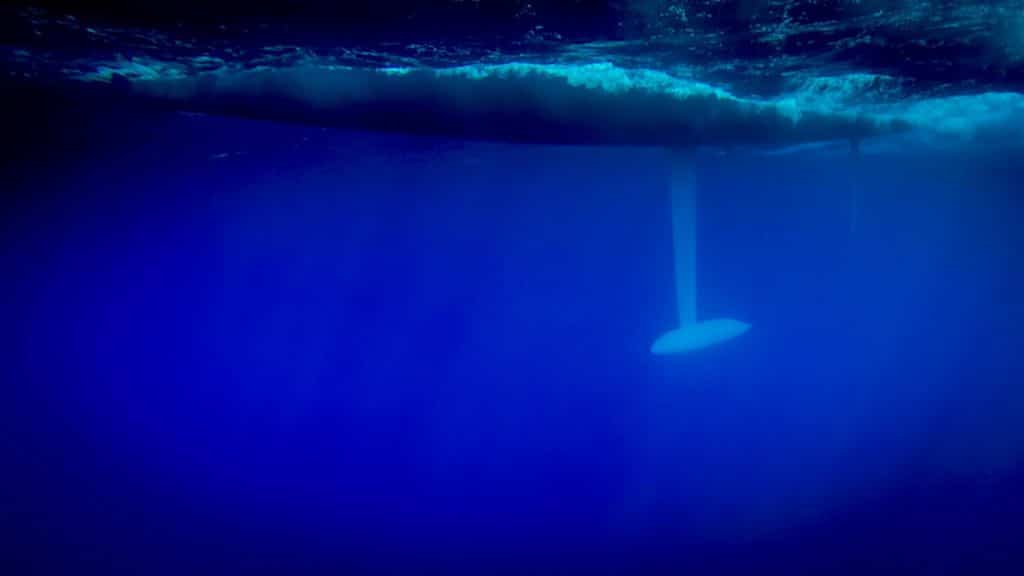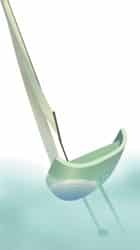
The underwater hull shape of your boat when it heels affects how much sailing length is put to work, how easy it is to steer, and how much horsepower it can carry aloft as the breeze increases. Consequently, some hull shapes must be sailed differently to get the best performance. To explain this concept, let’s compare three of my designs that represent common, but very different, hull shapes: a beamy IOR 40 called Chariot, the long and narrow Canadian 12-Meter True North I with pronounced overhangs, and a 50-foot deep-draft sportboat design, the Daniells 50.
Effective waterline length
A general design rule is that the longer the waterline, the higher the hulls speed potential. Perhaps the most important change when a boat is heeled is the length of the hull in the water, which is also known as effective waterline length or sailing length. Before the advent of rating rules based on computer performance prediction, designers working with point-measurement rules naturally strove to create hulls with more effective waterline length when heeled than what was measured for ratings purposes when the boat was upright.
The 12-Meter typified this design strategy. The simplest response to outwitting the waterline measurement process was a boat with generous overhangs at the bow and stern, which would stretch the sailing length when the boat heeled. The International Rule, created in 1906, sought to control excessive overhang by measuring a 12-Meters sailing length 7 inches above the load waterline (LWL). But there was just too much speed potential in overhangs for designers not to stretch the bow and stern above this point. When these long, narrow, and heavy designs heel to 25 degrees as shown, the deepest part of the hull remains along the centerline near amidships, but locations closer to the bow and stern shift their immersed volume to one side. When this happens, a significant gain in sailing length is achieved, especially at the stern, and a heeled modern 12 develops a particularly noticeable shift in underwater shape outboard of, and behind, the rudder.
Its a profoundly different shape than that of the sportboat, which was designed without any point-measurement rule to satisfy. This hull is typical of modern sportboat designs, which are either handicapped through computer performance prediction such as the IMS or race in one-design fleets. A clean underwater shape essentially shifts to leeward as the boat heels. Some gain in waterline length results, but not in the dramatic way of a Meter-class boat. Its not as important, the way it is with designs with pronounced overhangs, to get the sportboat to lay over just to increase hull speed.
Which brings us to Chariot and the issue of how heeling affects a boat’s performance beyond waterline length. Like the 12-Meter, the IOR design is based on a point measurement system. The International Offshore Rule, which was created in 1972, dominated offshore racing design in the 1970s and 1980s. While IOR competition has been superseded by the IMS and one-design offshore classes, the rule lives on in the hulls of many club-based racing keelboats built in an era when racer/cruiser designs routinely took their cue from SORC and Admiral’s Cup winners.
While Chariot isn’t the most extreme product of the IOR, it does show many typical IOR features: a somewhat triangular transom, deep forefoot, large skeg, and a fair amount of beam–emphasized by a designer because the rule assumed that fatter is slower than skinnier. As an IOR design heels, there’s a tendency to pick up sailing length. But because there’s so much volume gathered amidships, if it heels too far, it can begin to rise up, actually shortening the sailing length. As a result, this hull is far less tolerant of heel angle than less beamy designs.

Asymmetry, drag, and control problems
The narrower hull forms of the 12-Meter and the Daniells 50 also encounter far less form drag. This is the kind of parasitic drag an object experiences as its being pushed through a fluid, and the narrower a hull is relative to its length, the lower the form drag will be. Because of this, meter-boat hulls can drive comfortably to windward at high degrees of heel with minimum form drag, stretching their sailing length in the process. Its an advantage enjoyed by other long, narrow hull forms such as Dragons, IODs, and Etchells.
This brings us to another potential consequence of heel. Look at the shapes of the waterline planes in the heeled drawings. (It’s important to consider all the waterline planes, and not just the lightest colored one describing the sailing length.) With Chariot, they’re asymmetric, with long curves on the leeward side and near-straight lines to windward. The heeled 12-Meter displays a less extreme amount of asymmetry, while there’s hardly any with the Daniells 50. Asymmetry encourages the boat to turn to windward, which can lead to control problems. Those problems are compounded by the way a boat settles fore and aft as it rolls to one side.
In most cases, heeled hulls have more volume (read buoyancy) at the stern than the bow, which means that, to different degrees, they want to pitch bow down as they lean over. Even a boat as long and heavy as a 12-Meter benefits from moving crew weight aft as it heels, to counteract the tendency. The effect is most pronounced in Chariot, where it also has the most serious consequences because of things going on at either end of the waterline. IOR boats typically have a deep forefoot with a sharp bow knuckle, and if the bow gets a bite on the passing water as the stern lifts when reaching, a broach is in the making. The control problem is exacerbated by the rudder’s position. As with the 12-Meter, the rudder post is positioned at the end of the design waterline, and as the hull heels, more so in the case of the IOR design, the top of the rudder is in danger of becoming airborne if the stern is allowed to rise. It’s now vulnerable to ventilation down its low-pressure side, reducing efficiency and encouraging a total stall, just when the bow knuckle is digging in, and the heeled hull’s asymmetry is encouraging a sharp turn to windward.
The control problem is less of an issue with the 12-Meter, which lacks the sharp bow knuckle and generally has enough displacement to keep the rudder buried. And it’s least likely to crop up with a modern sportboat, whose shape is noticeably less beamy than that of Chariot, with a wider transom, flatter sections aft, no skeg, and a shallow forefoot. The rudder is positioned well forward of the design waterline’s aft end, and even when the hull is heeled 25 degrees, it’s at minimum risk of inducing ventilation. All that beam aft creates more waterline length when heeled, but at the same time the underwater shape remains symmetrical, which helps maintain a comfortable amount of weather helm. As with the other designs, moving crew weight aft when heeled is a good idea.
Target speed and heel angle
In 20 knots of true wind, our three designs have distinctive optimum performance parameters. Chariot has a target speed of 6.7 knots, but as the beamiest design, to get there the heel angle must be limited to 26 degrees, and sails must be reefed to 80 percent and flattened. The Daniells 50 will make 7.9 knots with the same sail management strategy, but its hull form permits a heel angle of 29 degrees. The 12-Meter True North I, the narrowest and heaviest of the lot, requires no reefing, only flattening of the sails, and can carry 30 degrees of heel as 8.3 knots are achieved.
How much heel your boat can actually tolerate can be investigated by some on-water pacing against an identical or similar design. If you dont have one already, install a heel gauge and pay attention to it as you draw your observations. An excellent resource to gather hard numbers on how your boat should be handled is US SAILING, which offers valuable performance packages on about 1,500 designs.









